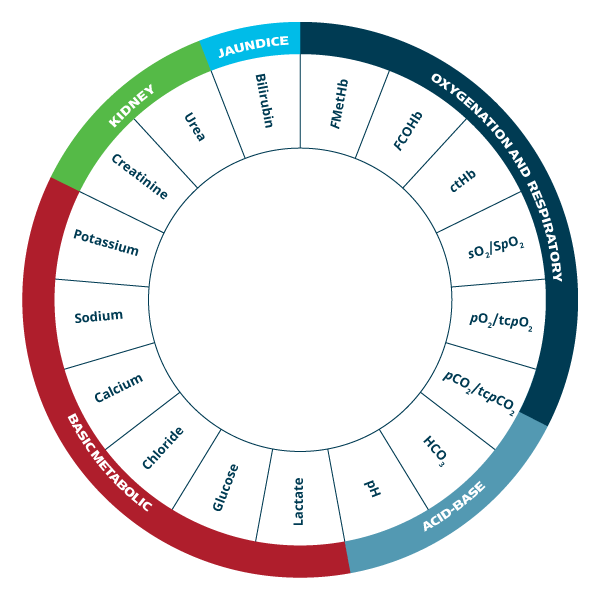Our NICU solution supports you in critical decision-making.
The possibility to change the course of a preterm neonate's life starts here. By providing you with insight into the neonate's condition, we aim to support you in making well-informed treatment decisions.
The dedicated NICU solution includes:
-blood gas testing on a very small blood sample
-continuous non-invasive transcutaneous monitoring of oxygen and carbon dioxide levels
The combination of advanced technologies and an extensive panel of tests gives you access to accurate and real-time information about the neonate’s condition.
Careful monitoring of the neonate
Neonates born premature may present a range of critical conditions that caregivers need to diagnose, treat and monitor. The care that neonates receive in the first hours and days can have a significant impact on their quality of life. [1,2]
In the short term, the recognition and treatment of critical symptoms can save the neonate’s life. [3]
In the long term, when caregivers provide correct and timely treatment and avoid life-altering complications, this helps contribute to better quality of life. [3]
The rapidly changing conditions of the neonate and undetected oxygen changes can be challenging in the neonatal intensive care unit (NICU). The NICU solution supports you in making diagnostic decisions and in caring for neonates.

Image Credit: Radiometer
Our NICU solution supports you in critical decision-making
The possibility to change the course of a preterm neonate's life starts here. By providing you with insight into the neonate's condition, we aim to support you in making well-informed treatment decisions.
The dedicated NICU solution includes:
- blood gas testing on a very small blood sample
- continuous non-invasive transcutaneous monitoring of oxygen and carbon dioxide levels
The combination of advanced technologies and an extensive panel of tests gives you access to accurate and real-time information about the neonate’s condition.

Overview of the parameters that you can measure with the Radiometer NICU solution. Image Credit: Radiometer
Combining blood gas testing and transcutaneous monitoring in the NICU
Dr. Sijo Francis explains how the NICU solution helps him improve patient outcomes at the neonatal intensive care unit (NICU).
See how transcutaneous monitoring gives him a real-time view of changes in a neonate’s physiology, lung status and ventilation.
Leading the way in caring for fragile patients
The beginnings of Radiometer were rooted in caring for fragile patients. The polio epidemic that swept Europe in 1954 was a crucial turning point in the formation of the company today. Dr. Poul Astrup approached us to support him in developing special equipment to help diagnose children with polio. [1, 2]
Radiometer continues to lead the way in the development of advanced medical devices for fragile patients with the NICU solution.
The combined blood gas and transcutaneous monitoring solution gives you detailed information on the neonate’s respiratory and metabolic status.
ABL90 FLEX PLUS blood gas analyzer
- 19 critical parameters on only 65 microliters of blood with creatinine and urea
- Dedicated 45 microliter Micromode measurement for capillary tube samples*
- Results in 35-60 seconds depending on mode
*Excluding creatinine and urea
TCM5 FLEX transcutaneous monitor
- System defined limits of site time vs. temperature help reduce the risk of harm from the heated sensor
- Real-time trending complements blood gas sampling
- Auto calibration keeps the sensor ready in the background
safeCLINITUBES capillary tubes
- Designed with rounded ends

Image Credit: Radiometer
References:
1. Ancel PY et al. Survival and morbidity of preterm children born at 22 through 34 weeks' gestation in France in 2011: results of the EPIPAGE-2 cohort study. JAMA Pediatr. 2015; 169, 3: 230-238.
2. Fanaroff AA et al. NICHD Neonatal Research Network. Trends in neonatal morbidity and mortality for very low birthweight infants. Am J Obstet Gynecol. 2007; 196, 2: 147.e
3. BOOST II United Kingdom Collaborative Group; BOOST II Australia Collaborative Group; BOOST II New Zealand Collaborative Group, Stenson BJ, Tarnow-Mordi WO. Oxygen saturation and outcomes in preterm Infants. N Engl J Med 2013; 368, 22:2094-2104.
4. Holbek CC. 25 years of RADIOMETER blood gas analyzers. Aspects of biomedical engineering in Denmark 1998: 133–41. 1.
5. Severinghaus J et al. Blood gas analysis and critical care medicine. AM J Respir Crit Care Med 1998; 157: S114-S122.